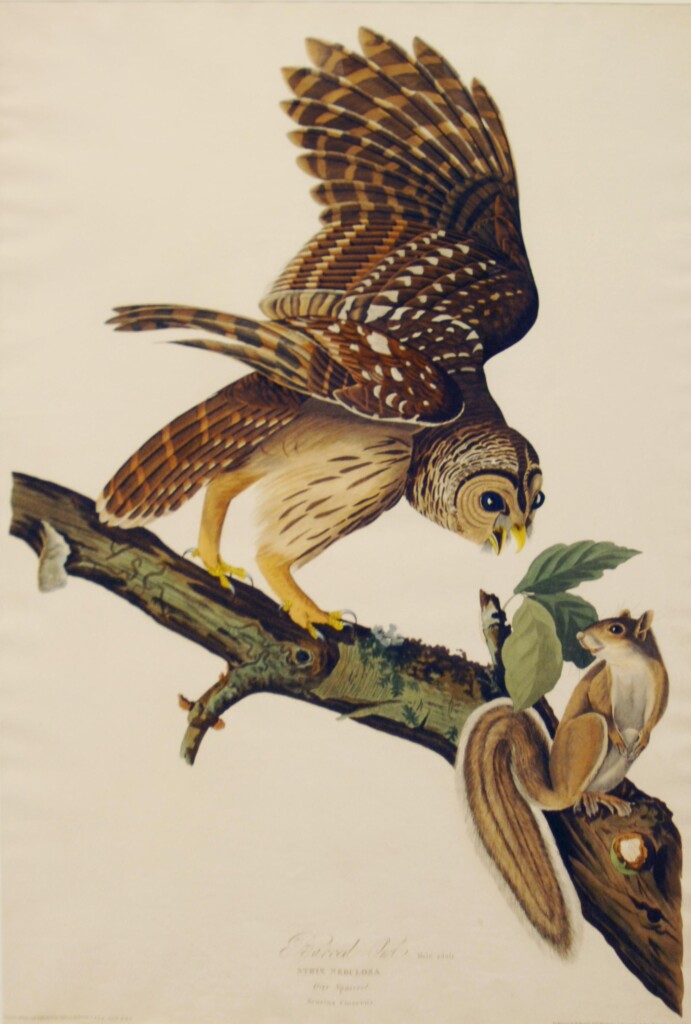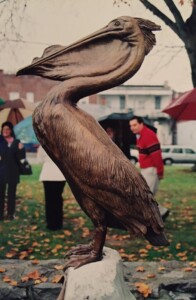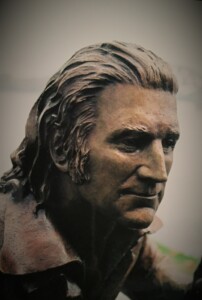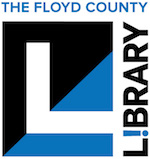Among the treasures preserved at the Carnegie Center for Art and History is a single, very large page of what would become the most ambitious printed book ever created. Long before the internet, information storage for images and words came in the form of costly to produce books that were often works of art themselves. This rare, hand-colored print is from John James Audubon’s monumental achievement, The Birds of America and was printed in London between the years 1827 – 1839. Our plate is number 46 and depicts in life-size, the Barred Owl (Strix varia) of our eastern forests regarding a gray squirrel (also life-size) on a shared tree branch as though startled or very hungry!

John James Audubon (1785-1851), Barred Owl, 1827-1839. Print, 36 x 32 inches. Carnegie Center for Art and History Collection, 2008.003. Gift of John Minton.
History has a way of providing funny little intersections in time. This print was given to the museum by John Minton in 2008 as a part of the local bicentennial celebration of the early Audubon at the Falls of the Ohio or “Chute de l’Ohio”. The artist inscribed this in French (his first language) on a few of his earliest preserved bird drawings created from his beloved Falls of the Ohio.
The year 2020 is proving to be a difficult one for us, but two hundred years ago…Audubon and his family were also going through a profound crisis. After Audubon’s second business venture failed, he and his family moved to Shippingport, KY in 1819. In 1820, Audubon, his wife Lucy, and their two boys leave their Ohio Valley home forever. From this point forward, Audubon would fully commit to traversing a still young continent to realize his dream of depicting every known American bird, life-size, in an amazing, tour-de-force book. To learn more about the book and to see all the bird prints click here, The Birds of America.
After 1820, Audubon in effect, re-taught himself how to draw birds including our Barred owl. His earliest attempts are good, but generally flatter in design and less rich in color. Over time, Audubon developed into a virtuoso graphic artist and used pastels, pencil, and watercolors to create dynamic compositions, subtle color effects, and textures that he observed in the living birds.
Here are a few other interesting facts about this work. Audubon created his Barred Owl study in 1821, the year after he left the Ohio Valley. The squirrel in our print, was drawn separately and at another time and would be added later by craftsmen at the Havell print shop where this image was pressed. The original drawing for the Carnegie Center print is preserved along with many other Audubon watercolors at the New York Historical Society, here is a link to this particular study of the Barred Owl.
When life returns to normal after the pandemic, a great Audubon/ I-64W road trip is visiting the John James Audubon State Park and Museum in Henderson, KY which is across the Ohio River from Evansville, IN. Preserved in their museum is a rare, complete set of all 435 plates of The Birds of America and many other artworks and heirlooms owned by the Audubon family. Here is their website link: John James Audubon State Park

Raymond Graf, based on Audubon birds, White Pelican.
While in Henderson, fans of public art might also enjoy visiting this Audubon-themed, walking tour around downtown Henderson Bronze Audubon Walking Tour. The bronze sculptures were commissioned from Raymond Graf, a Louisville sculptor, and former studio apprentice to the late Barney Bright. Each sculpture is a three-dimensional interpretation of a life-size bird from Audubon’s famous book. Graf also created the life-size, bronze Audubon portrait greeting visitors at Henderson’s riverfront Audubon Mill Park.

Raymond Graf, Portrait of John James Audubon.
Al Gorman, Coordinator of Public Programs and Engagement
Carnegie Center for Art and History
A branch of the Floyd County Library
April 14, 2020

